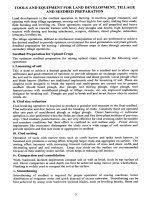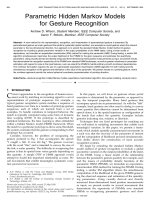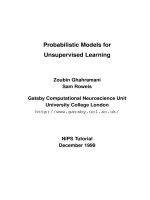Engineered hepatocellular models for drug development
Bạn đang xem bản rút gọn của tài liệu. Xem và tải ngay bản đầy đủ của tài liệu tại đây (5.85 MB, 145 trang )
!
!
“ENGINEERED HEPATOCELLULAR MODELS
FOR DRUG DEVELOPMENT"
ABHISHEK ANANTHANARAYANAN
B.TECH, SRMIST
A THESIS SUBMITTED
FOR THE DEGREE OF DOCTOR OF
PHILOSOPHY
NUS GRADUATE SCHOOL FOR INTEGRATIVE
SCIENCES AND ENGINEERING
NATIONAL UNIVERSITY OF SINGAPORE
2013
!
!
DECLARATION
I hereby declare that this thesis is my original work
and has been written by me in entirety. I have duly
acknowledged all sources of information which have
been used in the thesis
This thesis has not been submitted for any degree in
any university previously
Abhishek Ananthanarayanan
11
th
July 2013
!
!
Table of contents Page No
Summary 1
Acknowledgement 3
List of figures 5
List of tables 7
List of symbols 8
Chapter 1
Introduction to drug development 11
1.1 Introduction to drug development process
1.2 Need for in vitro models
1.3 Structure function relationship of the liver and
hepatocyte microenvironment
1.4 Cell types in the liver
1.4.1 Hepatocytes
1.4.2 Endothelial cells
1.4.3 Kupffer cells
1.4.4 Stellate cells
1.4.5 Oval cells
1.4.6 Pit cells
1.5 In vitro cellular models for drug development
1.6 Tissue engineering approaches and paradigms
1.7 Toolbox development for precision tissue engineering
1.7.1 Biomaterials for cellular assembly
1.7.2 Micro and nano- scale construct technologies
1.8 Purpose driven liver tissue engineering for applications
1.8.1 Cell models for pathogen testing
1.8.2 Hepatotoxicity testing
Chapter 2 36
Outline and specific aim of the thesis
2.1 Specific Aim 1
2.1.1 Hypothesis
2.1.2 Rationale
2.1.3 Experimental design
2.2 Specific Aim 2
2.2.1 Hypothesis
!
!
2.2.2 Rationale
2.2.3 Experimental design
Chapter 3 41
Scalable spheroid model of human hepatocytes to study HCV
infection and replication
3.1 Introduction
3.2 Background
3.3 HCV and host interactions
3.4 Viral proteins mediating entry
3.4.1 CD-81
3.4.2 SCARB-1
3.4.3 Claudin-1
3.4.4 Occludin-1
3.5 Mechanism of entry
3.6 Hepatitis C replication
3.7 HCV proteases
3.7.1 NS2-3
3.7.2 NS3-4A
3.7.3 NS 4B
3.7.4 NS 5A
3.7.5 NS 5B
3.8 Viral replication complex
3.9 Packaging and assembly
3.10Evasion of host responses by the virus
3.11Methods
3.11.1 Huh 7.5 cell culture
3.11.2 Human hepatocyte culture
3.11.3 Cell seeding
3.11.4 Synthesis of cellulosic scaffold
3.11.5 Scanning electron microscope
3.11.6 Live/dead staining
3.11.7 Immunostaining
3.11.8 Real time PCR
3.11.9 HCVpp synthesis
3.11.10 HCVpp entry and inhibition assay
3.11.11 Quantifying viral replication
3.12 Results
3.12.1 Characterization of spheroids in the scaffold
3.12.2 Characterization of spheroids using SEM
3.12.3 Characterization of presence of apical and
basolateral domain in spheroid cultured cells
!
!
3.12.4 Assessment of viability
3.12.5 Characterization of cellular phenotype
3.12.6 Expression of viral entry marker and
pseudoparticle entry
3.12.7 HCV live viral replication
3.13 Discussion
3.14 Conclusion
Chapter 4 81
Co-culture of rat hepatocytes and NIH 3T3 fibroblasts suppresses
drug induced CYP 450 responses via TGF β1 mediated
transcription factor inhibition
4.1 Introduction
4.2 Background
4.2.1 Factors eliciting toxicity
4.2.2 Liver enriched nuclear factors
4.2.3 CYP 450 enzymes
4.2.4 Phase II enzymes
4.2.5 Transporters
4.3 General mechanism of toxicity and liver injury
4.3.1 Aryl hydrocarbon receptor
4.3.2 Pregnane X receptor
4.3.3 Constitutive androstane receptor
4.3.4 Farsenoid X receptor
4.3.5 Peroxisome proliferator-activated receptor
4.4 Biotransformation, CYP induction and how it leads to
toxicity
4.4.1 Phase I
4.4.2 Phase II
4.4.3 Phase III
4.5 APAP metabolism as an example for toxic metabolite
mediated hepatotoxicity
4.6 Cytokines and their roles in liver disease
4.7 Materials and methods
4.7.1 NIH-3T3 culture
4.7.2 Rat hepatocyte isolation and culture
4.7.3 Hepatocyte synthetic function
4.7.4 CYP induction assay
4.7.5 RT-PCR
4.7.6 LC/MS measurement of CYP specific metabolites
4.7.7 Hepatocyte excretory function
4.7.8 TGF β1 pulldown
!
!
4.7.9 EROD assay
4.7.10Measurement of drug sensitivity
4.8 Results
4.8.1 Characterization of synthetic and metabolic
function of sandwich and co-culture
4.8.2 Comparing drug sensitivity and drug induction
between co-culture and sandwich culture
4.8.3 TGF β1 is an important regulator of hepatocyte
function
4.8.4 TGF β1 is an important factor regulating CYP
induction in co-culture
4.8.5 TGF β1 and co-culture enhance hepatocyte
excretion
4.9 Discussion
4.10 Conclusion
Chapter 5 119
Recommendations for future research
5.1 Liver tissue engineering
5.2 Hepatotoxicity testing and improving predictivity
5.3 Hepatitis C infections and drug development
References 125
1!
!
Summary:
Primary hepatocytes of adult human and rodent origin are essential components for
developing drugs against infectious pathogens and for studying drug mediated liver
toxicity. One of the key drawbacks limiting the use of these primary hepatocytes in
vitro is their rapid loss of differentiated function, polarity, inability to recapitulate
drug responses accurately and failure to capture the life cycle of pathogens.
Although multiple platforms have been developed to improve functional maintenance
of hepatocytes in culture, there is little understanding on the utility of these models for
applications like toxicology and infections by various liver specific pathogens. In this
thesis we have studied the utility of spheroid cultures of human hepatocytes to support
hepatitis C infection and replication and sandwich culture of rat hepatocytes and co-
culture of rat hepatocytes with fibroblasts for drug testing applications.
Spheroid culture models of human hepatocytes and human hepatoma cells maintain
and enhance liver specific functions, while localizing various liver specific proteins at
domains similar to that found in vivo. These spheroid models maintain polarity over
prolonged cultures and support glycoprotein mediated HCV entry. Huh 7.5 also
support higher levels of replication of HCV virus in vitro. This makes it a suitable
model to screen for drugs inhibiting HCV entry and replication.
Rat hepatocyte culture with fibroblasts (co-culture) enhances hepatocyte specific
synthetic and metabolic functions. However co-culture of hepatocytes with fibroblasts
inhibits drug-induced CYP 450 responses. We found that TGFβ1 is an important
cytokine in co-culture responsible for repression of drug-induced responses. Soluble
factor mediated repression of drug-induced CYP 450 responses makes co-culture an
unsuitable model to study drug induction/inhibition and drug-drug interactions.
2!
!
We have analyzed the strengths of different hepatocyte culture models and
demonstrated the strengths of different models for applications pertaining to drug
development.
3!
!
Acknowledgements:
I am indebted to my supervisor Prof Hanry Yu for giving me independence and
freedom to define my thesis and also execute it with tremendous amounts of support.
The idea of doing this thesis came about after talks with different pharmaceutical
industries like Johnson and Johnson and Hoffman La Roche pharmaceuticals who
were interested like rest of the pharmaceutical world in the 2 major points of focus in
this thesis namely Hepatotoxicity and HCV replication in vitro. Prof Yu was
instrumental in my visit and collaborative efforts with both these pharmaceutical
giants to understand the needs of the industry.
To my thesis advisor Dr Michael McMillian, I owe my deepest gratitude for many
insightful discussions and making me understand the nuances of mechanistic toxicity
and understanding the biology behind various toxic responses. To Dr Miriam Triyatni,
Dr Surya Sankuratri and Dr Stefan Hart for discussions on characterization of the
model for Hepatitis C infection and useful discussions on HCV biology and the
problems the pharmaceutical industry is facing to combat this virus.
I would like to also thank my colleagues Bramasta, Narmada, Justin, Inn Chuan,
George Annene, Yee Han, Yi Chin and Derek Phan for all the wonderful discussions
and support over the last 5 years and making it a wonderful sojourn
I would also like to thank all LCTE members and members at Institute at
Bioengineering and Nanotechnology past and present for letting me to work with
them over these 5 years in a conducive lab environment.
Finally I would like to thank my parents for being my advisors, friends, philosophers
and guides all my life without which this dissertation would not be possible.
4!
!
List of publications:
1. Ananthanarayanan.A. et al. 2011 “ Systems Biology in Biomaterials and
Tissue Engineering”. Comprehensive Biomaterials. Elsevier
2. Ananthanarayanan.A., et al. 2011 “ Purpose driven biomaterials research
in liver tissue engineering” 29 (8):110-8. Trends in Biotechnology (Cover
March 2011)
3. Shufang Zhang, Wenhao Tong, Baixue Zheng, Thomas Adi Kurnia Susanto,
Lei Xia, Chi Zhang, Abhishek Ananthanarayanan, Xiaoye Tuo, Sakbhan
Rashidah Binte, Rui Rui Jia, Ciprian Iliescu, Kah Hin Chai, Michael
McMillian, Shali Shen, Hwa Liang Leo, Hanry Yu. 2011. A robust high
throughput sandwich cell based drug screening platform. 32 (4):1229-41.
Biomaterials
4. Lei Xia, Yinghua Qu, Sakban Rashidah Binte, Xin Hong, Wenxia Zhang,
Bramasta Nugraha, Wenhao Tong, Abhishek Ananthanarayanan, BaiXue
Zheng, Ian Yin-Yan, Rui Rui Jia, Michael McMillian, Jose Silvia, Shanon
Dallas, Hanry Yu. 2012“Tethered spheroids as a hepatocyte in vitro model
for drug hepatotoxicity screening” 33 (7):2165-76
5. Hanry Yu and Abhishek Ananthanarayanan. “Introduction to Cellular
and Tissue engineering”. 2013 Imaging in cellular and Tissue engineering.
Taylor and Francis
6. Baixue Zheng and Abhishek Ananthanarayanan.2013”Confocal
Microscopy for Cellular Imaging: High-Content Screening”. Imaging in
cellular and Tissue engineering. Taylor and Francis
7. Ananthanarayanan. A et al. 2013. “Scalable spheroid model of human
hepatocytes for HCV infection and replication” (Manuscript to be submitted)
8. Ananthanarayanan et al. 2013. “ Co-culture of rat hepatocytes with NIH 3T3
suppresses drug induced responses via TGF β1mediated transcription factor
inhibition” (manuscript to be submitted)
5!
!
List of figures:
Figure 1. Schematic of drug discovery process
Figure 2: Reasons for drug failure
Figure 3. Global in vitro toxicology market estimates
Figure 4: Various liver functions
Figure 5: Lobular model of the liver
Figure 6: Acinar model of the liver
Figure 7: Various liver cells and their arrangement
Figure 8: in vitro and in vivo models used in drug development
Figure 9: Various technologies to engineer in vitro liver
Figure 10: History of Hepatitis C infection
Figure 11: Mechanism of viral entry
Figure 12: HCV life cycle
Figure 13: Structure of HCV virus
Figure 14: Synthesis of cellulosic sponge
Figure 15: Size distribution of spheroids in cellulosic scaffold
Figure 16: SEM images of spheroids of Huh 7.5 and Primary hepatocytes
Figure 17: MRP2 and CD147 staining of Huh 7.5 and Human hepatocytes
Figure 18: Cell tracker green (Live/Dead staining) of Huh 7.5/ Human hepatocytes
Figure 19: Gene expression profile of Huh 7.5 and Human hepatocytes in spheroid
culture
Figure 20: Localization of Viral entry markers and pseudoparticle entry in Huh 7.5
and human hepatocytes
Figure 21: Comparison of HCVpp entry between Monolayer and Spheroids in Huh
7.5 cells and human hepatocytes
Figure 22: CD-81 dependent entry of HCVpp into Hepatocytes and Huh 7.5 cells
Figure 23: JFH-1 replication in spheroid culture of Huh 7.5 cells
6!
!
Figure 24: Fold change in JFH-1 copy number of spheroid compared to monolayer
Figure 25: Proportion of drugs metabolized by CYP 450 enzymes
Figure 26: Schematic description of sinusoidal and basolateral transporters
Figure 27: Schematic of AhR activation
Figure 28: Schematic of PXR activation by ligand
Figure 29: Characterization of rate of Urea production in Sandwich cultured and co-
cultured hepatocytes with NIH 3T3 cells
Figure 30: Characterization of rate of albumin production in Sandwich cultured and
co-cultured hepatocytes with NIH 3T3 cells
Figure 31: Fold change in enzyme activity levels of co-culture normalized to
sandwich culture
Figure 32: Comparison of sensitivity of sandwich and co-culture to paradigm
hepatotoxicant APAP
Figure 33: Comparison of drug induced responses between sandwich and co-culture
at transcript and activity levels upon exposure to paradigm CYP 450
inducers.
Figure 34: Effect of TGF β1 on rate of Urea synthesis in sandwich cultured
hepatocytes
Figure 35: Effect of TGF β1 on the transcript levels of important liver specific
enzymes and EROD activity
Figure 36: Fold change in the transcript levels of CYP 450 enzymes induced in the
conditioned media and media depleted of TGF β1
Figure 37: Fold change in the transcript levels of CYP 450 enzymes induced in the
presence and absence of TGF β1
Figure 38: Fold change in the transcript levels of transcription factors in the presence
and absence of TGF β1 normalized to uninduced controls
Figure 39: Hepatocyte excretory function
7!
!
List of Tables:
Table 1: Various cellular models for drug development and their advantages and
disadvantages
Table 2: Integration of various tissue engineered models into applications
Table 3: Viral evasion strategies
Table 4: Human hepatocyte specific primers
Table 5: Characterization of spheroid number in the scaffold
Table 6: Rat hepatocyte specific primers
8!
!
List of Symbols:
ADME: Absorption, distribution, metabolism and excretion
APAP: Acetaminophen
ARE: Antioxidant response element
AhR: Aryl Hydrocarbon receptor
BSEP: Bile salt excretory pump
CYP 450: Cytochrome P450
CAR: Constitutive Androstane receptor
DDLT: Dead donor liver transplant
DILI: Drug induced liver injury
ECM: Extracellular matrix
eIF: Eukaryotic Initiation factor
ER: Endoplasmic Reticulum
FDA: Food and Drug administration or Fluorescein di-acetate
FXR: Farsenoid X receptor
GST: Gluthathione S transferase
GAG’s: Glycosamino glycans
Huh 7.5: Human hepatoma 7.5 cells
HNF: Hepatocyte nuclear factor
HCV: Hepatitis C Virus
HBV: Hepatitis B virus
HIV: Human immunodeficiency virus
HDL: High density lipoprotein
iPS: Induced pluripotent stem cells
9!
!
IL: Interleukin
ISG: Interferon Stimulating genes
IRF: Interferon regulatory factor
IRES: Internal Ribosome entry site
IFN: Interferon
LDL: Low density lipoprotein
LDLT: Living donor liver transplant
LPS: Lipopolysaccharide
MRP: Multidrug resistant associated protein
MDR: Multidrug resistant protein
MOI: Multiplicity of infection
Nrf2: NFE related factor 2
OS/RM: Oxidative stress/ reactive metabolite
OATP: Organic anion transporting pump
PPAR: Peroxisome proliferator activated receptor
PCN: Pregnonelone carbonitrile
PXR: Pregnane X receptor
PEG: Polyethylene glycol
PLLA: Poly-l-lactic acid
PGA: Poly glycolic acid
RIG: Retinoic acid inducing gene
STAT: Signal transducer and activator
SAA: Serum Amyloid A
si and sh RNA: Small interfering and short hairpin RNA
10!
!
TGFβ1: Transforming growth factor Beta 1
TRIF: TIR domain containing adapter inducing interferon β
TLR: Toll Like receptors
TNF: Tumor necrosis factor
UGT: Uridine 5’-diphospho glucuronosyl transferase
VLDL: Very low density lipoprotein
XRE: Xenobiotic response element
11!
!
Chapter 1
Introduction
12!
!
1.1 Drug development process:
Development of a new drug and its launch into the market costs over a billion dollars
over a period of 12 years, which makes it a very time consuming and expensive
process [1].
Figure 1: Schematic of drug discovery process (Adapted from
www.gsdpharmaconsulting.com).
The discovery phase starts with identification of the best targets specific to a disease.
Identification of drug targets allows for chemists and biologists to perform targeted
drug discovery by high throughput screening of existing chemical or biological
libraries or de novo structure based design [2]. As seen from the above schematic
there is a huge attrition in the number of compounds from early phases of drug
discovery to compounds entering clinical trials. It is less than 0.1% of the compounds
developed initially are suitable for testing on human subjects [3]. Due to such
stringent control and safety and efficacy assessment it takes between 6-9 years for one
13!
!
compound to enter the market as a marketable drug [1]. It can therefore be observed
that there is a huge attrition in the number of compounds generated and number of
compounds that enter clinical trials. The problem is further accentuated by the fact
that the number of failures remains high even in phase 3 of development for example
in the case of cancer over 50% of the drugs fail to progress. This is mainly due to the
fact that most in vitro screens do not pick up 90% of the toxicity [3]. Many of the
compounds also fail due to unacceptable toxicity seen in many of the preclinical
animal models. These toxicities observed are not necessarily correlated with
toxicities observed in humans due to interspecies differences in toxicological
responses [4]. This fact is further supported by the failure of a number compounds in
clinical trials due to adverse drug reactions mainly affecting vital organs like the liver,
heart and kidneys.
Figure 2: Reasons for drug failure a) NCE’s by large UK companies b) NCE’s
excluding anti-infectives (Adapted with permission from Kubinyi et al [5])
Apart from toxicity to various organs many of the drugs also fail due to poor
bioavailability, lack of efficacy, commercial reasons and pharmacokinetics as shown
in Figure 2.
14!
!
Current drug development paradigms mainly employ in vitro models using animal or
human cells and preclinical studies involving various animal species for efficacy and
safety assessment of compounds. However, there are a number of pathogens and other
infectious agents, which can be studied only in humans and in biological material of
human origin [6]. Use of animal models in preclinical testing and ethical issues
involved with drug testing in humans makes it notoriously difficult to develop drugs
targeting these pathogens. This is evident from the fact that over the years it has been
extremely difficult to develop effective drugs or vaccines against hepatitis C, hepatitis
B, HIV and various forms of influenza. However tremendous progress has been made
to manage HIV and the FDA has recently approved 2 new drugs telaprevir and
boceprevir to cure chronic hepatitis C of genotype 1 and 2.
1.2 Need for in vitro models
From these pitfalls observed with the current strategy, there is a huge unmet need for
in vitro models for developing new drug entities and predictive toxicology. The
concept of fail early, fail cheap will have considerable economic value to
pharmaceutical companies.
These models could also have tremendous implications by contributing to the
understanding of the life cycle of various pathogens from early stages of infection all
the way until capturing life cycle of the pathogen [7]. These strategies could be used
to understand the pathophysiology of diseases at a molecular level and also aid in
identification of novel targets and leads [8]. For various toxicology applications these
models could aid in understanding mechanisms of toxicity and can aid in
understanding the toxicity detected during preclinical studies. This information can be
then obtained and rational drug design can be performed [9]. These models can also
15!
!
be used to ascertain human risk during preclinical studies. Furthermore, they are more
reproducible than in vivo models, easier to utilize and are popular since it necessitates
the reduction of animals used during preclinical studies [10].
These observed pitfalls of the current strategy despite the huge costs currently
involved, has prompted huge investments into development of physiologically
relevant and predictive in vitro models. With the number of drugs losing their patent
protection there is an urgent need to develop newer drugs in challenging areas of
medicine and market analysts are forecasting a $2.7 billion investment for these
technologies by 2015.
Among these the pharmaceutical industry contributes to a major part of the
investment with a value estimated at $976 million by 2015 at an annual compounded
growth rate of 19.5% (Figure 3).
Figure 3: Global in vitro toxicology market estimates (Source:
www.bccresearch.com)
16!
!
Among the various in vitro models being developed to predict various organ toxicities
in the pharmaceutical industry, a great amount of focus and efforts have been driven
towards building predictive models of the liver; which plays a very vital role in
maintaining normal homeostasis [11] and is subject to infection by various pathogens
and also plays an important role in the first pass metabolism of various xenobiotics.
1.3 Structure function relationship of liver and hepatocyte microenvironment:
The liver possesses an extremely efficient design. It consists of the reactor bed, a flow
manifold and system, which deliver nutrients and metabolic products to the blood
stream while shunting bile into the bile duct. The main functions are to remove toxins
and to perform metabolic activity like cytochrome P450 based metabolism, glycogen
storage, and to release cholesterol lipids and metabolic wastes. It also helps store iron,
copper, fat-soluble vitamins and blood. In all there are more than 500 functions of the
liver and many of them are very important to support life.
Figure 4: Various liver functions
17!
!
The two main competing views of the structural organization of the functional units of
the liver are the lobule and the acinus [12]. Both models have hexagonal arrangement
with the portal triads at the periphery and central vein at the centroid. In Kiernan’s
proposed model blood enters the periphery from the digestive system through the
portal triad and exits via the central vein after passing through the sinusoids. The
portal triad consists of 3 vessels carrying oxygenated blood from the heart via hepatic
artery, portal vein carrying enriched blood from the intestines and bile duct carrying
bile from the bile ducts. These structures branch out and supply and drain the entire
liver.
The acinar model proposes that the blood passes through the sinusoids and the oxygen
content and nutrient concentration is varied based on contact of the blood with the
hepatocytes. Therefore the cell types in the liver are heterogenous and whose
functions differ as a result of composition of the contacted blood [12]. The acinus is
divided into three zones based on oxygen concentration and distribution of nutrient
concentration. Isolation of the sinusoid shows the functional fundamental unit of the
liver a set of thin hepatocyte plates called acinus strung between the portal triad and
hepatic venule. These 2 models are therefore the foundation of models of liver
architecture.
18!
!
Figure 5: Lobular model of the liver (Adapted with permission from
Cunningham et al [13])
Further at the cellular level the liver has a very intricate organization, which might be
necessary for achieving high levels of function. The acinus is organized as a sponge
like structure which is perfused and has a plate of mature hepatocytes organized with
single cell thickness knows as the parenchyma [14].
These plates have 2 domains; the apical domain, which has the bile canaliculi and the
basal domain, which is in contact with the ECM and sinusoidal blood. These plates
are lined by fenestrated endothelial cells, which create a physical and chemical link
between the sinusoid and hepatic plate. Stellate cells traverse the region between the
sinusoid and hepatic plate. The kupffer cells are interspersed between the sinusoids.
The fluid flows mainly from the portal region to the central vein. Hepatocytes also
form ducts known as bile canaliculi, which transport bile. These ducts are separated
from the rest of the tissue by tight junctions.
19!
!
Figure 6: Acinar model of the liver (Adapted from www.meddean.luc.edu)
1.4 Cell types in the liver
Four cell types, line the normal hepatic sinusoid each with specific phenotypic
characteristics, functions and topography. These cells participate in many disease
processes and also various liver functions.
1.4.1 Hepatocytes:
Hepatocytes are highly differentiated cells, which are present in the liver. These cells
contribute to over 60-65% of the liver population. They play vital roles in
detoxification, secretion of plasma proteins, growth factors, metabolism of proteins,
storage of fats, vitamins, iron and glycogen [15].
1.4.2 Endothelial cells:
Endothelial cells constitute the closed lining or wall of the capillary and make up 18-
23% of hepatic cells. They possess small fenestrations, which allow for diffusion of









